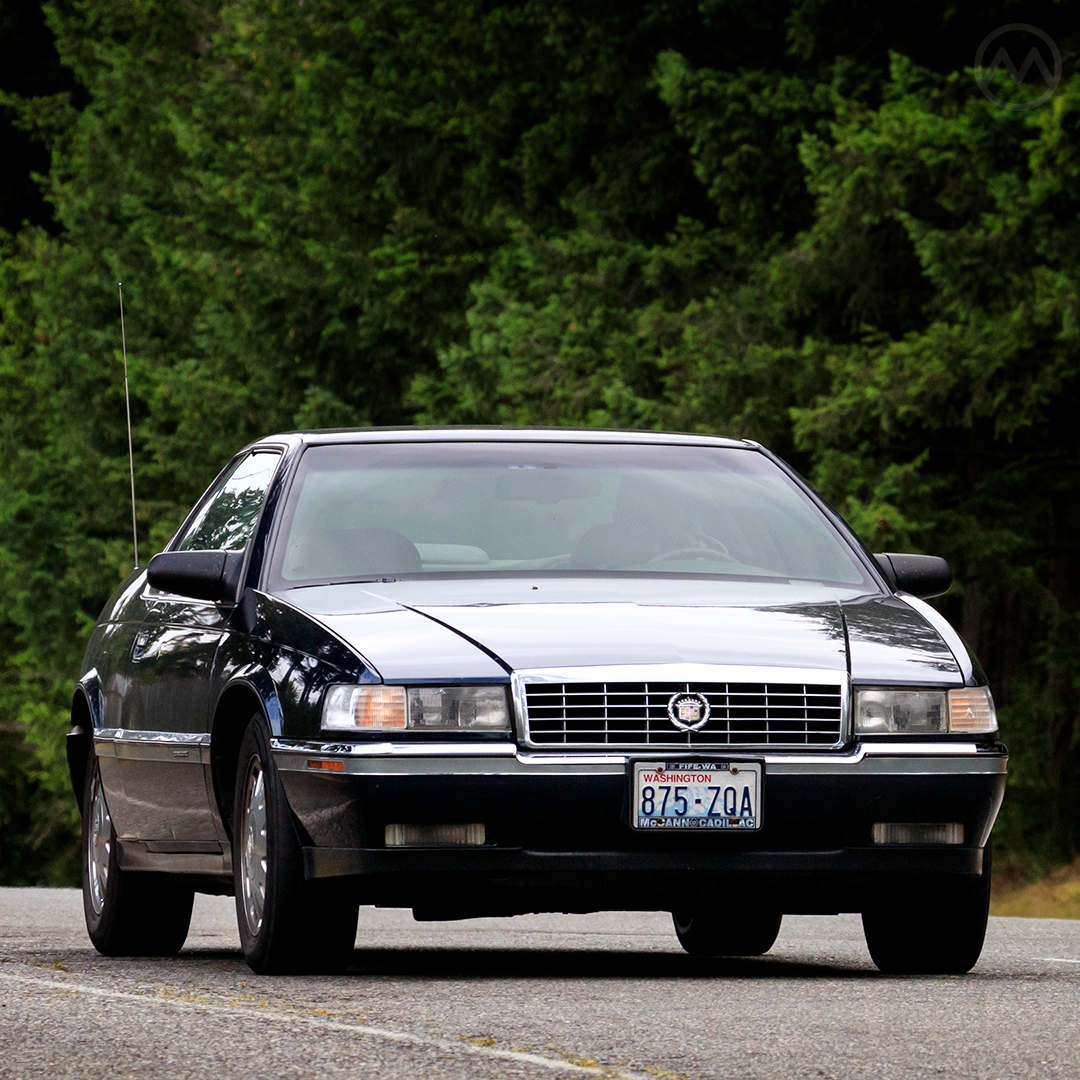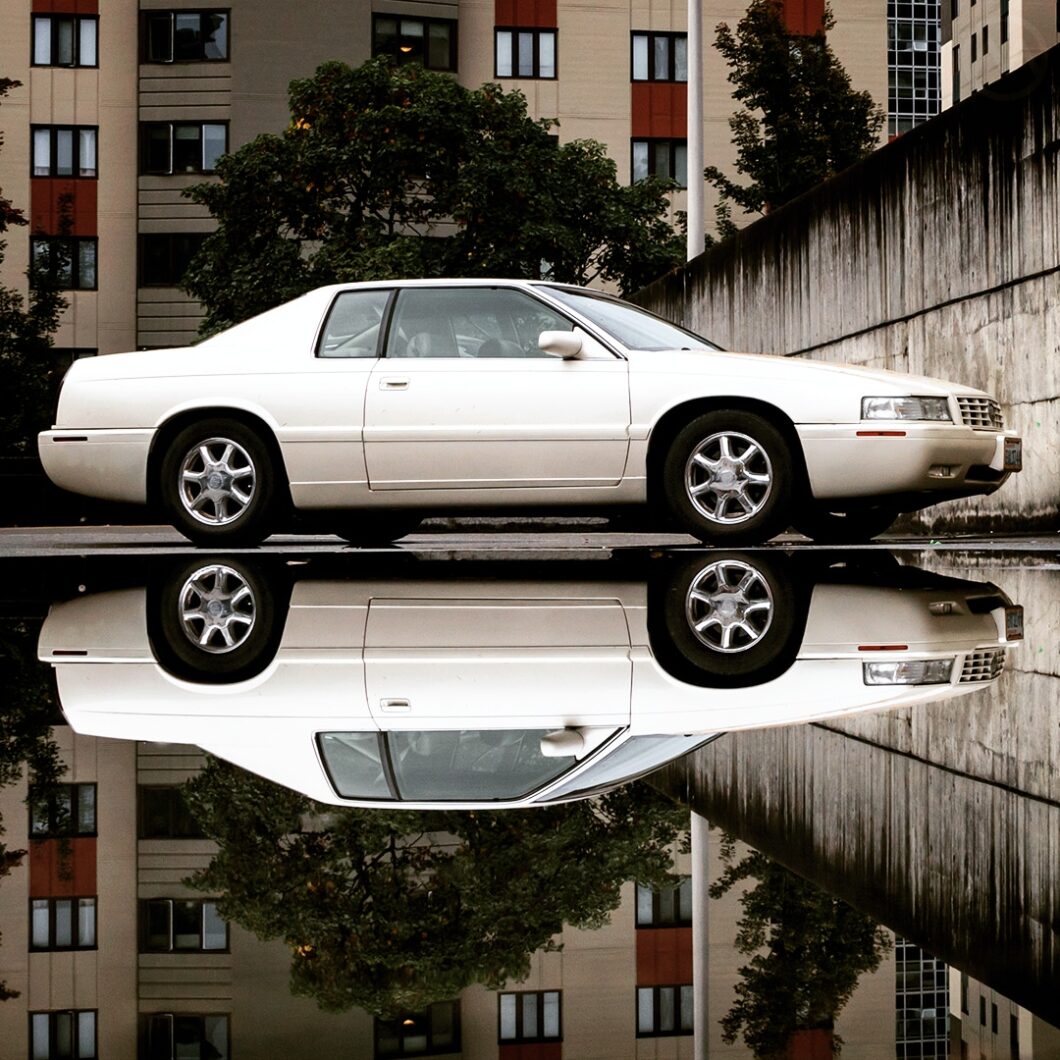The classic American personal/luxury car universe came to a close on Monday, April 22, 2002. That day, Earth Day by coincidence, the final Cadillac Eldorado rolled off the line at the Lansing Craft Center in Michigan. In a way, it was hard to believe it had lasted that long, as the Eldo seemed like a car out of time even in the showrooms that year. By then, its only real contemporaries, the related Buick Riviera and Lincoln’s futuristic MkVIII, were both long gone, and the Lexus SC had been redesigned into a different format. Cadillac itself was in the midst of yet another reinvention.
While this Eldorado’s 4-door sister, the 1992-97 Seville, is often regarded as the first brick in Cadillac’s modern foundation, the Eldo was arguably the last vestige of its past. That is, of course, not at all what was intended when the final Eldorado was being designed or what GM hoped for. While these two cars may have been futuristic for Caddies in 1992, they were playing different missions, and the Eldo’s fate seems almost inevitable in hindsight.
The Bad Old Days
Both cars were meant to banish memories of the brand’s high-profile 1980s flubs, but the Seville had an easier time of things. Sevilles had a history of breaking with Cadillac tradition from the car’s very inception in 1975, and thus the design team was freed from most traditional Cadillac constraints and tropes. That served that car well in a new world dominated by Acura, BMW, and Lexus.
The Eldorado, on the other hand, catered to a very specific niche of buyer, and the era of the personal luxury coupe was in its twilight by the early 1990s. GM hoped to regain some of the Eldo’s past mojo with this very modern design, but there just weren’t enough customers for that to ever truly happen.
The story begins with the disastrous downsizing of the Eldorado, Seville, Buick Riviera, and Oldsmobile Toronado in 1986. With the fuel crisis experiences of 1973 to 1980 fresh in their mind, GM’s management plowed right ahead with wave after wave of downsizing, finally migrating its largest cars to far smaller front-drive platforms in 1984-85. The E-body cars (and K-body Seville) were already front-drivers, but they got smaller too for 1986. Too small.
Sales of all four cars (Buick Riviera, Cadillac Eldorado and Seville, Oldsmobile Toronado) fell off a cliff when customers got a look at these vehicles. They simply looked too much like the cheaper and smaller N-body compact cars (Somerset, Grand Am, Cutlass Calais) thanks to their shrunken size and formal rooflines.
It’s worth noting that even the designers were not thrilled with the layout they were given for these cars, and openly complained about the ’86 E-Car’s proportions and distinctiveness when they were given the mechanical and structural layouts. Their protestations fell on deaf ears, though they did try their best to make them look good. It wasn’t the last time GM’s best designers would be overruled.
They lacked the presence of their predecessors, and their makeover happened at exactly the wrong time. Sales would likely have fallen anyway as late 1980s buyers seemed to desert the coupes they’d loved so much in the previous decade. The transition of many Baby Boomers into parenthood meant a boom in SUV sales while impractical coupes declined, and younger buyers always favored sporty over luxurious.
The icy reception that the downsized ‘86s received gradually thawed by enlarging and restyling the coupes, and similar treatments would follow on the full-size front-drive GM cars in the early 1990s, but it was really too late. Sales of the E-body cars never recovered to their early 1980s levels. Clearly, however, a major rethink was in order for Cadillac, and the brand seemed to make one misstep after another for most of the decade, not helped by GM’s byzantine and hamfisted internal reorganizations.
New Blood
In 1988, new division boss John Grettenberger (and GM’s upper management) gave the design team a free hand for the next E/K cars. In 1988-89, designer Dick Ruzzin was brought in from Chevrolet (fresh off finishing the 1991 Caprice) to helm the exteriors. Interior designer Marv Fisher charged with rethinking virtually all of Cadillac’s cabin design philosophy, which had not changed much since the mid-1970s.
Former GM F-body engineer (who’d lobbied hard in 1974 to save those cars from cancellation) and GM-10 program manager Bob Dorn was Cadillac’s chief engineer. After the V-4-6-8 and HT4100 fiascos, GM was keen to restore Cadillac’s reputation, and Dorn led a group that greatly improved the quality of the products and the engineering underneath them. Dorn himself later said that this period in his career helped put Cadillacs “Back on the playing field with the best cars in the world.” Not all of the creations of this era aged well, but they were a big step up from where things had been in the early 1980s.
The existing K/E-body architecture was heavily updated with a far more rigid structure and a new independent rear suspension. A brand new engine, the Northstar V8, was developed for the cars although it wasn’t ready until their sophomore year, in 1993). The Northstar is probably remembered as the weak link in this era of Cadillacs, but in the early days, it was the best engine the division had used since the demise of the old 368 V8 in 1981.

Designing the 1992 Cadillac Eldorado
Ruzzin’s team had only two and a half years to come up with and execute an entirely new direction, and they drew only modest inspiration from previous Cadillacs for the Seville. The 1988 Voyage show car informed the Seville’s roofline, but Ruzzin later said that car, designed by advanced studio staffer Jerry Brockstein, reflected themes that were already in motion. It’s also credited with inspiring the 1991 Caprice, but Ruzzin had already completed that vehicle before moving to Cadillac around the time the Voyage debuted in public. Brockstein and Ruzzin were friends, and no doubt compared notes.
The real story, however, is that Cadillac pitted its own in-house team against Pininfarina, who were fresh off designing the Allanté, in a competition to design the new Eldo. Assistant chief designer Dennis Little later attested that there was also another challenge: Cadillac dealers were almost in open revolt in 1985-86 over Cadillac’s many problems and the poor reception of the ’86 Eldorado. At one of the first meetings he attended, some dealers threatened to drop their franchises, so the pressure was on.
Ultimately, GM’s own designers prevailed against less distinctive proposals from Pininfarina, but there was also the matter of sharing pieces with the Seville to contend with. Ultimately, while visually similar up front, the two cars used different panels. The Eldorado reflected much of the design ethos of the Seville, but was more traditional in every respect. It kept the upright Cadillac taillights, a trademark since 1960, and the fat C-pillars of classic Eldos with a greenhouse that mimicked the 1967 version.
Compared to earlier versions, this new Eldorado was spare and slick, and much larger than the outgoing 1991 model. It was 11 inches (28cm) longer and 3 inches (7cm) wider, and looked handsomely chiseled. The Northstar wasn’t ready yet, but the car was launched to generally good reviews in late 1991. The Seville, of course, drew even more praise and acclaim, and for the first time in a long time positive comparisons to imported luxury cars.
1992 saw sales sharply rise from 1991’s low 15,000 car total, but that was the high-water mark. Buyers just didn’t want these big coupes anymore. When it came to expensive two-doors, the ever-smaller numbers of nineties buyers were looking for performance, and while the Northstar-powered Eldo had almost 300 horsepower on tap, it was never a machine characterized by a sporty feel, even in “Eldorado Touring Coupe” form. Even the Acura Legend Coupe and Lexus SC were on borrowed time when Cadillac gave the Eldo a mild refresh in 1995.
By the late 1990s, the car had acquired many advanced modern features like stability control, an adaptive suspension, and rain-sensing wipers, but sales continued to dwindle.
Cadillac also let the final Eldo wither on the vine. Selling less than 25,000 units a year after 1992, and sometimes much less, a full redesign was hard to justify, so it continued on into 2002 with only modest updates, and production moved to the small-batch Lansing facility. The Eldo’s age, high cost, and massive depreciation made it a poor value compared to newer cars like the Mercedes CLK by the turn of the millennium. Few would have cross-shopped the two, though, as CLK buyers perceived Cadillacs as being for old people.
In 2002, Cadillac launched the CTS, its opening salvo in yet another remake of the brand (the stealth-fighter-look one that’s still with us today), and by then the brand had also acted on a Grettenberger suggestion that GM management had initially shot down — a Cadillac SUV. Traditionalists may have mourned the Eldo, but dealers celebrated the Escalade and have continued to do so ever since.

